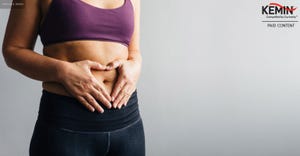October 8, 2012

Not a day goes by without some news about health claims dominating the headlines. Whether it's the newest class action suit, the potentially game-changing developments coming out of POM Wonderful v. FTC, or the latest controversial EFSA ruling, the regulatory environment is wild and woolly. It's the continued evolution of a channel that has undoubtedly come a long way, but is still in the process of establishing its position in the world. Suppliers and manufacturers are forced to operate in the midst of this fiery birthing process, which means dealing with ambiguity and sometimes crippling limitations.
Whatever the mature industry comes to look like, it has always been clear that regarding health claims, the most important driver is having good science and using it well (i.e., scientifically accurate, legally compliant and compelling claims are the three keys). Notwithstanding, and indeed because of, the current push-pull, there is a strong ethic that is increasingly emerging. In the early days after the passage of the Dietary Supplement Health and Education Act of 1994 (DSHEA), it was a struggle to point to good studies that substantiated the claims everyone was using. It's gratifying to see the number of companies that now take research seriously. Whether it's a supplier providing support to help develop claims, or a manufacturer that puts in the time to design and support labels and messaging points properly, the industry is focusing on generating good science, understanding what it is saying, and using it well.
But in the same way that the big picture is evolving, knowing how to go from science to claim is also an evolving competency within companies. It's a combination of scientific research acumen, regulatory expertise and marketing savvy. Sometimes, it's difficult to get all of these talents together in a room, or certain pieces are missing. When they do come together, each piece pulls for its own interests. The outcome is always the product of compromise, which doesn't have to be a bad thing. But parties often doubt whether the science is being communicated well, the wording could be stronger or even if claims are left on the table.
A practice that can assist with all of the above is a simple, but powerful tool: writing it down. That is, getting onto paper in an organized, informed way, the science a company has, the specific data that are claim-generating, and the wording of the claims that complies with the three keys. Then, the data can be synthesized according to its merit and "claim-worthiness." An individual or team skilled in science and regulations that knows the industry well can fairly pick out the claims and be clear about the strength of the substantiation behind them. This is where science becomes science-ability, which ultimately results in creating a strong foundation for all aspects of product development and launch.
Unity
Given the many complexities of the industry and health claims in particular, one step separates those who use it well and those who don't: inviting a multi-disciplinary team to contribute. The idea is to include the insight and needs of key stakeholders into the design of the claims and their role in the product story. Roughly, the team should consist of a representative from science, regulatory, marketing, sales, legal and public relations. An introduction to the science by an inspiring team member can bring the nonscientists on board and get their juices flowing. Ideally, it's a dynamic brainstorming session that generates a clever and creative middle ground that allows the value of the product to shine through, while considering important interests and limitations.
This is the gold. Because from there, the stakeholders create unity. When the final claims language is devised by consensus and is written down in a summarizing document, it is in a form that everyone can use, and it has buy-in. This unity creates confidence in the message, which translates into strong component pieces coming out of each department. Doing this early in the product development process creates fertile ground for creativity and strength in designing all aspects of the product launch.
The Claims Substantiation Dossier
Taking the process to the next level in writing a claim substantiation dossier is an opportunity to create a comprehensive guiding resource that serves numerous purposes. First, it provides solid, written documentation of substantiation for claims defensea necessity in this regulatory climateand the peace of mind that brings. It also serves as a go-to reference for all departments, ensuring a consistent and strong overall product presentation. Lastly, it provides a jumping-off point for planning new research and products. An added benefit for ingredient suppliers: a modified version serves as an outstanding value-add for customers.
The dossier should be designed in such a way that it clearly lays out the pertinent information. For example, it should:
Name the exact ingredient/food/extract
Define the intake level to which the claims pertain, as derived from literature
List the claim(s) and categories of claims (e.g., heart health and energy claims for the same ingredient) and all wording variations, as derived from the literature and the input of the team
Provide pertinent scientific background on the ingredient, the health area it affects or its specific value-adds
Cite and detail the papers that substantiate the claim(s), summarizing them concisely, but with the necessary detail to understand the specific substantiation
Include the full spectrum of the literature
The ideal person to write the dossier should have a good working knowledge of science, regulatory and marketing; barring that, it can be a jointly produced document.
The clarity and effectiveness that comes with the completion of a claim substantiation dossier in this way shines through in how the team works with, talks about and sells the product. A little effort early in the product development process pays off manifold.
Risa Schulman ([email protected]), Ph.D., is a functional food and dietary supplement expert, professional speaker and writer. She is president of Tap~Root, a consulting company focusing on health claim substantiation, product development and business strategy. Drawing on 15 years of experience on the leadership teams of companies such as POM Wonderful, Solgar Vitamins and Mars Botanical (a division of Mars Inc.), she assists prominent and pioneering food and dietary supplement companies, ingredient suppliers and companies shifting into these spaces with straddling the science-regulatory-marketing challenges of product development and launch.
At the SupplySide West eucation session, "Truthfully Advertising Your Dietary Supplements: Advertising Claims, Evidence and Self-Regulation," attendees can learn more about designing strong health claims. The session is from noon to 12:50 p.m. on Wednesday, Nov. 7 in Las Vegas.
View the Slide Show: SupplySide West Dietary Supplement Education for an overview of the education the show offers the supplement industry.
You May Also Like




.png?width=800&auto=webp&quality=80&disable=upscale)